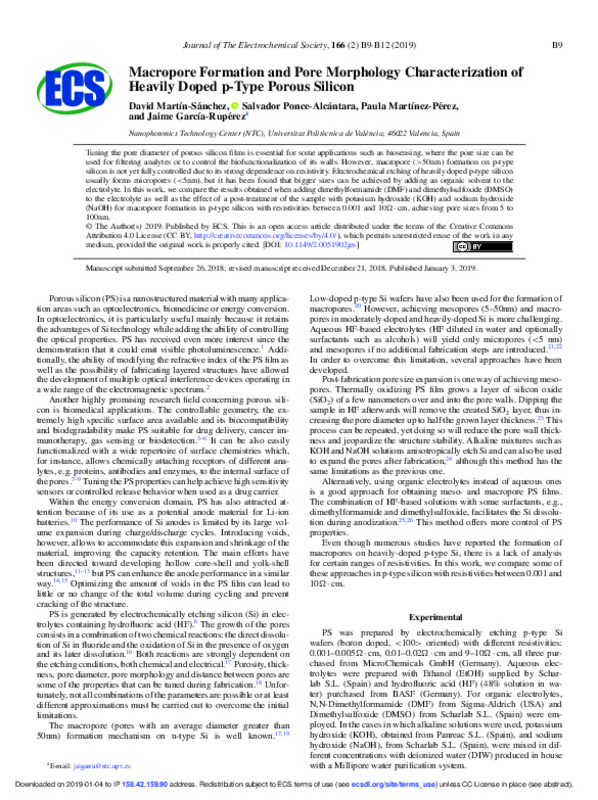Canham, L. T. (1990). Silicon quantum wire array fabrication by electrochemical and chemical dissolution of wafers. Applied Physics Letters, 57(10), 1046-1048. doi:10.1063/1.103561
Dhanekar, S., & Jain, S. (2013). Porous silicon biosensor: Current status. Biosensors and Bioelectronics, 41, 54-64. doi:10.1016/j.bios.2012.09.045
Pacholski, C. (2013). Photonic Crystal Sensors Based on Porous Silicon. Sensors, 13(4), 4694-4713. doi:10.3390/s130404694
[+]
Canham, L. T. (1990). Silicon quantum wire array fabrication by electrochemical and chemical dissolution of wafers. Applied Physics Letters, 57(10), 1046-1048. doi:10.1063/1.103561
Dhanekar, S., & Jain, S. (2013). Porous silicon biosensor: Current status. Biosensors and Bioelectronics, 41, 54-64. doi:10.1016/j.bios.2012.09.045
Pacholski, C. (2013). Photonic Crystal Sensors Based on Porous Silicon. Sensors, 13(4), 4694-4713. doi:10.3390/s130404694
Hutter, T., Horesh, M., & Ruschin, S. (2011). Method for increasing reliability in gas detection based on indicator gradient in a sensor array. Sensors and Actuators B: Chemical, 152(1), 29-36. doi:10.1016/j.snb.2010.09.058
Mariani, S., Strambini, L. M., & Barillaro, G. (2016). Femtomole Detection of Proteins Using a Label-Free Nanostructured Porous Silicon Interferometer for Perspective Ultrasensitive Biosensing. Analytical Chemistry, 88(17), 8502-8509. doi:10.1021/acs.analchem.6b01228
Caroselli, R., Ponce-Alcántara, S., Quilez, F. P., Sánchez, D. M., Morán, L. T., Barres, A. G., … García-Rupérez, J. (2017). Experimental study of the sensitivity of a porous silicon ring resonator sensor using continuous in-flow measurements. Optics Express, 25(25), 31651. doi:10.1364/oe.25.031651
Ashuri, M., He, Q., & Shaw, L. L. (2016). Silicon as a potential anode material for Li-ion batteries: where size, geometry and structure matter. Nanoscale, 8(1), 74-103. doi:10.1039/c5nr05116a
Ashuri, M., He, Q., Liu, Y., Zhang, K., Emani, S., Sawicki, M. S., … Shaw, L. L. (2016). Hollow Silicon Nanospheres Encapsulated with a Thin Carbon Shell: An Electrochemical Study. Electrochimica Acta, 215, 126-141. doi:10.1016/j.electacta.2016.08.059
Ashuri, M., He, Q., Liu, Y., Emani, S., & Shaw, L. L. (2017). Synthesis and performance of nanostructured silicon/graphite composites with a thin carbon shell and engineered voids. Electrochimica Acta, 258, 274-283. doi:10.1016/j.electacta.2017.10.198
Ashuri, M., He, Q., Zhang, K., Emani, S., & Shaw, L. L. (2016). Synthesis of hollow silicon nanospheres encapsulated with a carbon shell through sol–gel coating of polystyrene nanoparticles. Journal of Sol-Gel Science and Technology, 82(1), 201-213. doi:10.1007/s10971-016-4265-z
Liu, N., Huo, K., McDowell, M. T., Zhao, J., & Cui, Y. (2013). Rice husks as a sustainable source of nanostructured silicon for high performance Li-ion battery anodes. Scientific Reports, 3(1). doi:10.1038/srep01919
Yi, R., Dai, F., Gordin, M. L., Chen, S., & Wang, D. (2012). Micro-sized Si-C Composite with Interconnected Nanoscale Building Blocks as High-Performance Anodes for Practical Application in Lithium-Ion Batteries. Advanced Energy Materials, 3(3), 295-300. doi:10.1002/aenm.201200857
Föll, H., Christophersen, M., Carstensen, J., & Hasse, G. (2002). Formation and application of porous silicon. Materials Science and Engineering: R: Reports, 39(4), 93-141. doi:10.1016/s0927-796x(02)00090-6
Zhang G. X. , in Modern Aspects of Electrochemistry, Vayenas C. Gamboa-Adelco M. E. , Springer, Boston, USA, (2006).
Canham L. T. , in Handbook of porous silicon, Canham L. T. , Springer International Publishing, Switzerland (2014).
Lehmann, V., & Föll, H. (1990). Formation Mechanism and Properties of Electrochemically Etched Trenches in n‐Type Silicon. Journal of The Electrochemical Society, 137(2), 653-659. doi:10.1149/1.2086525
Lehmann, V., & Ronnebeck, S. (1999). The Physics of Macropore Formation in Low‐Doped p‐Type Silicon. Journal of The Electrochemical Society, 146(8), 2968-2975. doi:10.1149/1.1392037
Lehmann, V., Stengl, R., & Luigart, A. (2000). On the morphology and the electrochemical formation mechanism of mesoporous silicon. Materials Science and Engineering: B, 69-70, 11-22. doi:10.1016/s0921-5107(99)00286-x
Mariani, S., Pino, L., Strambini, L. M., Tedeschi, L., & Barillaro, G. (2016). 10 000-Fold Improvement in Protein Detection Using Nanostructured Porous Silicon Interferometric Aptasensors. ACS Sensors, 1(12), 1471-1479. doi:10.1021/acssensors.6b00634
Lau, H. ., Parker, G. ., & Greef, R. (1996). High aspect ratio silicon pillars fabricated by electrochemical etching and oxidation of macroporous silicon. Thin Solid Films, 276(1-2), 29-31. doi:10.1016/0040-6090(95)08042-2
Chernienko, A. V., Astrova, E. V., & Zharova, Y. A. (2013). Zigzag structures obtained by anisotropic etching of macroporous silicon. Technical Physics Letters, 39(11), 990-993. doi:10.1134/s1063785013110175
Ponomarev, E. A., & Lévy-Clément, C. (2000). Journal of Porous Materials, 7(1/3), 51-56. doi:10.1023/a:1009690521403
Haldar, S., De, A., Chakraborty, S., Ghosh, S., & Ghanta, U. (2014). Effect of Dimethylformamide, Current Density and Resistivity on Pore Geometry in P-type Macroporous Silicon. Procedia Materials Science, 5, 764-771. doi:10.1016/j.mspro.2014.07.326
Rasband W. S. , U. S. National Institutes of Health, Bethesda, Maryland, USA, 1997.
Mawhinney, D. B., Glass, J. A., & Yates, J. T. (1997). FTIR Study of the Oxidation of Porous Silicon. The Journal of Physical Chemistry B, 101(7), 1202-1206. doi:10.1021/jp963322r
[-]









